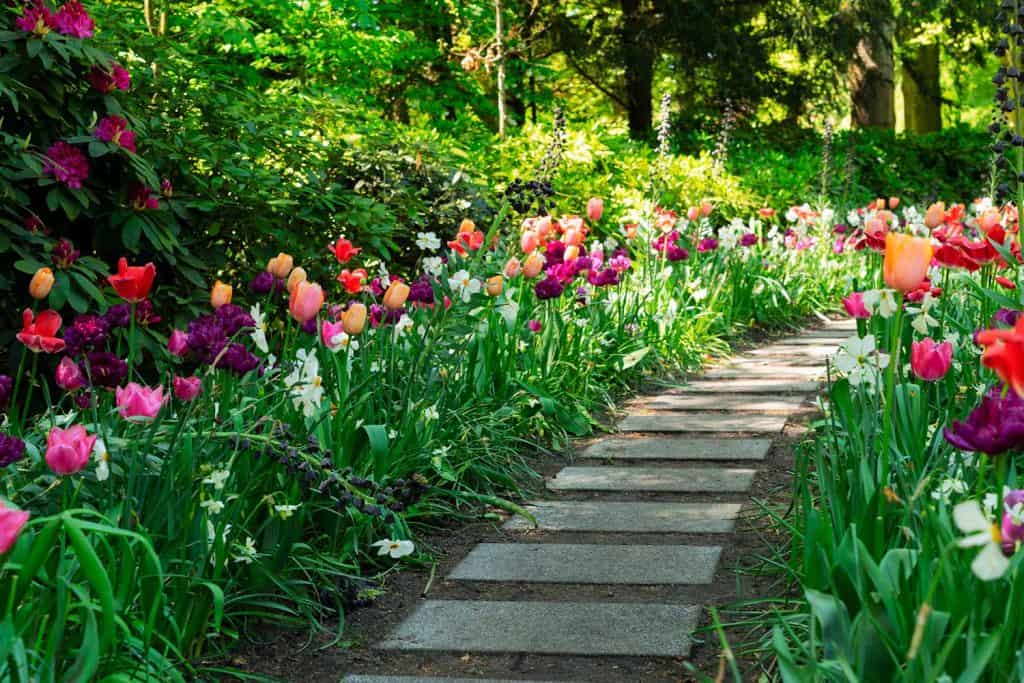 When Spring arrives, one of your garden's first guests is the bright, eye-catching tulip. Determining the best location for these gorgeous blooms is key for a successful display. We have researched some tried-and-true tips for introducing these staple flowers to your garden and helping them thrive.
When Spring arrives, one of your garden's first guests is the bright, eye-catching tulip. Determining the best location for these gorgeous blooms is key for a successful display. We have researched some tried-and-true tips for introducing these staple flowers to your garden and helping them thrive.
When you're planting your tulip bulbs, make sure that you've considered soil depth, drainage, sunlight, and visual appeal.
- Plant tulip bulbs about 4 inches apart and 4 inches deep (depending on the variety) from the top of the bulb in well-drained soil.
- Tulips prefer full sunlight, but will also thrive in partial shade.
- Plant your tulips away from your home so that the bulbs will stay cool during the wintertime.
- Tulips look best planted in large numbers or alongside other bulbed flowers, like crocuses or hyacinths.
These specifications may apply to a lot of areas in your yard, so we've put together this detailed guide that will show you the best places to plant your bulbs, how to plant them, and what other plants and flowers they are compatible with.
Where to Plant Tulips in Your Garden

Soil with Adequate Draining is Vital
Tulips are generally grown from a bulb, meaning they are particularly susceptible to fungi and molds. It's important that your soil has adequate drainage and that you don't plant your bulbs where they may be perpetually wet, like at the bottom of a slanted yard.
If you have clay-heavy soil, you can add peat moss, aged manure, or compost to improve drainage.
Plant Away From Heat
The bulbs must also be kept cool during the winter as part of their dormancy phase. Keeping them away from artificial heat sources, like your house, allows them to stay healthy enough to produce those showy blooms in the springtime.
In fact, tulips grow best when they've gone through the dormancy phase, which is why experts suggest you plant them in the fall.
Plant Enmasse for a Stunning Display
With so many varieties and colors available and their uniquely symmetrical shape, the tulip's appeal is undeniable. When a tulip is standing alone, however, it tends to look like a lanky, awkward girl left out of the school dance. Don't let your tulip be a wallflower! Many gardeners plant dozens of tulips in swaths at a time for a "field" of color.
Use as a Backdrop for Shorter Flowers
Another option is to plant shorter flowers that have the same blooming season around the tulips. You can aim for placement that gives the garden a polished look, with rows of tulips in the back of the bed and shorter flowers stair-stepped in front, or you can scatter your bulbs for the feeling of a fancy-free batch of wildflowers. Some low-flowering bulbs that nicely fill in the spaces between the tulips are anemones and crocuses.
Interplant with Plants with Different Bloom Times
Other flowers can act as a cover when your tulips begin to fade as well. Certain perennials, like dianthus and coneflowers, will start to bloom just as your tulips begin to droop, giving your garden some floral longevity. Other excellent coverage perennials include columbine, bleeding heart, and forget-me-nots.

To Dig, or Not to Dig
There are two modes of thought surrounding the end of a perennial tulip's growing season. Because the bulb's first bloom is usually the healthiest and most colorful, many gardeners choose to dig up their tulip bulbs and replant fresh bulbs in the fall.
If you're less concerned with the quality of the bloom, the tulips you plant now may not need to be dug up for four years or more. If your flowers leave something to be desired, try digging the bulbs up and moving them to a sunnier spot.
Can I Plant Tulips in My Vegetable Garden?
Tulips are ideal for beautifying your garden plot before your tomatoes make an appearance, and ensure that you can make a lovely, floral centerpiece to dress your Mother's Day table. These early risers spark up in late April and early May, giving them plenty of time to bloom before you plant a majority of your warm-weather crops.
Be sure to consider the crop space you're using with your tulip variety. Plant your tulips in the fall after you've harvested warm-weather crops, then pull the bulbs up before planting the next round of vegetables.
Can I Plant on Top of Tulip Bulbs?
Your tulips have died, and now you have an ugly, bald spot in your flower bed. What's a gardener to do? While it seems innocent enough to plant annuals overtop your tulip bulbs, those annuals require lots of water and fertilizer to produce quality blooms.
Tulips do not do well in wet environments, and while you're watering your annual flowers, you may be rotting out your tulip bulbs. Instead, you can keep your annuals in pots on top of the tulips so they aren't overwatered, or you can pull the bulbs and save them for next fall.
Even more about tulips
If you love tulips - and who doesn't? - we think you'll find these articles interesting too -
Variegated & Striped Tulips Guide (Including types and Images)
Black Tulips (pictures, gardening tips, and shopping links)
